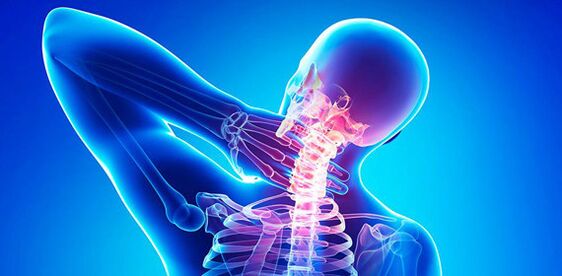
There is no adult who has never experienced neck pain in his life. Every fourth woman and every sixth man experience it all the time. A sedentary lifestyle and time spent in front of the computer exacerbate the problem. Neck pain can also occur due to arthrosis of the shoulder joint and any other disease in this area, in the upper back and arms or the back of the head. From this article you can learn all about neck pain and how to get rid of it.
Causes of neck pain
The most common causes are the following diseases:
- Cervical osteochondrosis, complicated by protrusion or herniation of intervertebral discs. The most common and important cause of neck pain. Pain is associated with pinching of spinal nerve roots by partially or completely destroyed intervertebral discs. The pain is very strong, sudden, can be localized only in the neck (on one or both sides) or radiate to other areas - in the head, back of the head, arm, back, under the shoulder blade, etc. pain therapy, restoration of cartilage tissue of discs and strengthening of neck muscles. Sometimes such patients need the help of a neurosurgeon to remove the destroyed disc.
- Ankylosing spondylitis (rheumatoid spondylitis, ankylosing spondylitis) is an autoimmune inflammatory process in the joints of the cervical spine. The disease usually develops gradually, imperceptibly, spreading along the spine from the bottom up. The cervical region is the last to be affected. It is manifested by pain in the neck, stiffness of movement, which disappears after the start of physical activity. Over time, the pain intensifies and the spine becomes immobile. Long-term treatment with a rheumatologist will help.
- Arthrosis of the facet joints of the cervical spine (uncovertebral arthrosis). The cause of pain in the neck and back of the head in this case is degenerative-dystrophic changes in the small joints that connect the neck vertebrae. It is often of professional origin, develops when working in an immobile state with a bent or forcibly turned head, or after suffering injuries. Symptoms: pain at the site of the lesion, radiating into the shoulder and grinding when moving, sometimes headache, dizziness, high or low blood pressure, hearing loss. Treatment by neurologists and rheumatologists.
- Torticollis is a change in the position of the neck that prevents turning the head and other movements. It can be congenital (in children) and acquired (in adults) after injuries, on the background of rough skin scars, persistent spasm of cervical and occipital muscles during degenerative-dystrophic and inflammatory processes in the spine and surrounding soft tissues. Symptoms: tilting of the head and raised shoulder on the affected side, pain in the neck and back of the head when trying to tilt the head in the opposite direction. The pain increases with physical activity and stress. Treatment can be conservative (for spasms) or surgical, performed by a surgeon or orthopedic traumatologist.
- Myofascial pain syndrome (MPS) is associated with irritation of the nerve endings in the muscles, leading to muscle spasm and pain.
Clinical anatomy of the neck
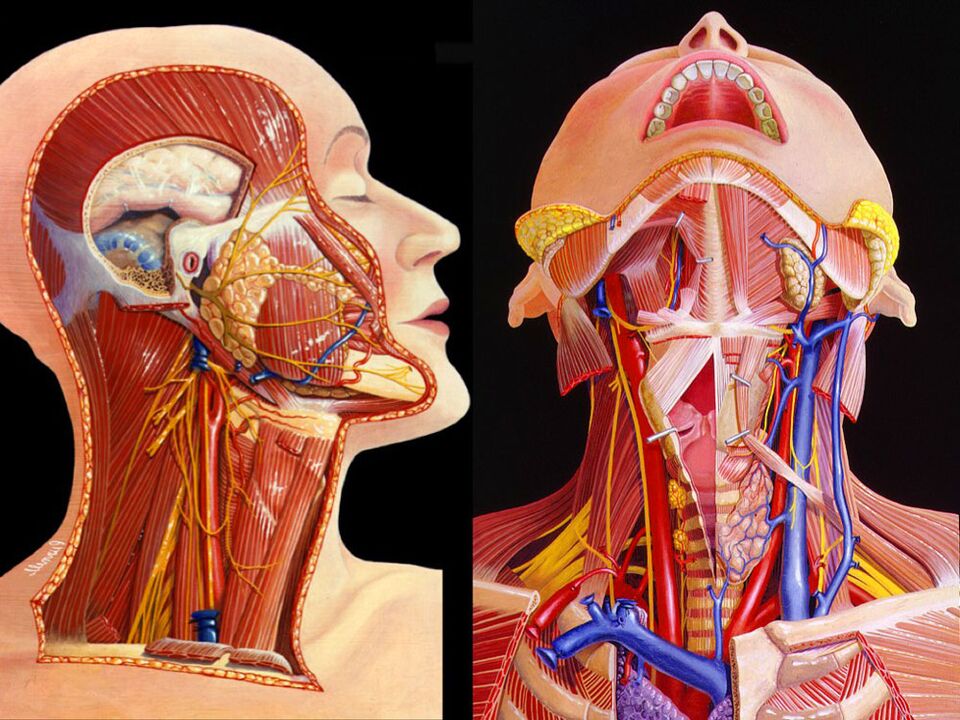
In the case of degenerative-dystrophic diseases of the spine, as well as arthritis of the facet joints (between individual vertebrae), bony growths or swollen soft tissue can compress the vertebral artery, which leads to impaired blood flow to the brain, headaches and dizziness. . Pain can also be the result of compression of the spinal roots that extend from the spinal cord. Along the brachial nerve plexus, such pain radiates into the arm.
First aid for neck pain - what to do
Neck pain can gradually increase, but sometimes it occurs acutely, suddenly in the form of lumbago with radiation to other areas. It is hard to endure such suffering. What to do, how to get rid of them?
Tablets and ointments for neck pain
Emergency Self-Help Algorithm:
- Take a sedative - panic only makes the situation worse; you can take: 20 drops of soothing drops or a tablet with a solution of the substance levomenthol in menthyl isovalerate under the tongue; these drugs not only relax, but also dilate blood vessels, which in turn helps to reduce muscle spasm and associated pain; You can also take 1-2 tablets of valerian extract or any other sedative you have on hand.
- Take painkillers (optional).
- To get rid of painful pain, you can use external painkillers: ointments, gels, plasters.
Exercises against neck pain
If the pain is not very strong, is of a painful nature and is combined with stiffness, then you can try to get rid of it with the help of exercises. They should be performed smoothly, without sudden movements. An approximate set of exercises that relieve pain:
- initial position (IP) – lying on the back, head on a flat pillow; Press your head firmly against the pillow and hold until you count 5; take a break and repeat; do 5-7 approaches;
- IP - lying on the left side, head on a flat pillow; raise your head and keep it in that position until you count to 5; take a short break, then at least five approaches;
- IP - lying on the side on the right side; repeat the previous exercise on the right side;
- IP - lying on the stomach, hands folded on the back of the head; raise your head, resisting with your hands; each approach – 5 seconds with a short break, repeat 5 – 7 times.
It is contraindicated for the relief of severe acute pain with exercises.
In such cases, it is better to keep the neck still, using, for example, a Shants collar. But prolonged immobilization leads to weakening of the muscle corset and worsening of the situation. Therefore, the Shants collar can be used to reduce pain before consulting a doctor. Only an expert can determine the duration of immobilization.
After you completely or partially eliminate the pain syndrome yourself, it is necessary to visit a doctor, otherwise it will return and it will be quite difficult to alleviate it.
Exercises against neck pain
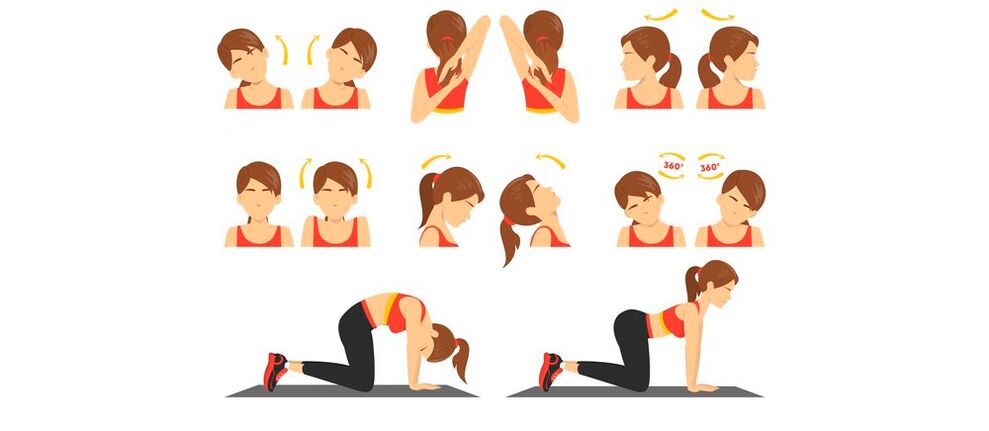
What not to do if you have neck pain
If you often have neck pain, remember that you should not:
- being in a forced position for a long time with a tense neck - a painful muscle spasm develops;
- lift weights, perform heavy work - microtrauma of the spine with nearby tissues occurs, gradual destruction of cartilaginous and bone structures;
- they are often exposed to stress - they are accompanied by vascular spasms, which negatively affects blood circulation and the condition of the spine;
- smoking, frequent alcohol consumption – contributes to permanent vasoconstriction;
- hypothermia - muscles located near the spine become inflamed, myositis develops;
- sleeping on a high soft pillow means staying in an uncomfortable static position for a long time;
- make sudden head turns - a sudden pinching of the nerve and the appearance of severe pain are possible.
When you need to see a doctor urgently
Do not hesitate to seek medical help if:
- neck pain occurs regularly and cannot always be completely relieved by painkillers;
- you experienced a painful attack for the first time or have already experienced it several times, when any movement brings severe suffering;
- pain syndrome is accompanied by general disorders: fever, chills, etc. ;
- suddenly there was an acute short-term pain in the neck on the left side that radiated to the arm, shoulder blade or the back of the head - a sign of an acute circulatory disorder in the region of the heart muscle (angina attack);
- sudden attacks of headache and dizziness appeared, sometimes with loss of consciousness - a sign of compression of the vertebral artery.
If such symptoms appear, there is no point in treating it: it will only make the problem worse. No folk remedies or grandmother's advice will help.
Only a doctor can help relieve pain by creating an individual treatment plan based on an examination and accurate diagnosis. If you are in doubt about which doctor to consult, go to see a therapist, he will understand the situation and, if necessary, refer you to another specialist.
Types of neck pain and how to deal with them
The pain syndrome can manifest itself in different ways: only on one side of the neck or everywhere, locally or radiating to other parts of the body. Let's try to understand what the appearance of pain indicates and what to do in each specific case.
Severe pain in the neck due to corona virus and ARVI
All viral infections can be accompanied by neck pain. This is due to intoxication caused by an infectious agent. When the person recovers, these symptoms disappear.
But in some people, after a few days or weeks after the viral infection, the pain syndrome appears again, sometimes it is accompanied by swelling of the spine and stiffness of movements (head turns with difficulty to the side) in the morning.
This condition requires immediate examination, as it may be associated with autoimmune processes in the facet (connecting vertebrae) joints of the spine.
Infection with the corona virus seriously affects the immune system, causing various disorders in its functioning. If a person has a predisposition to an autoimmune process (close relatives suffering from such diseases), then it is quite possible that a viral infection will serve as a starting point (trigger) for its onset. What to do: see a therapist or rheumatologist.
Severe neck pain and fever
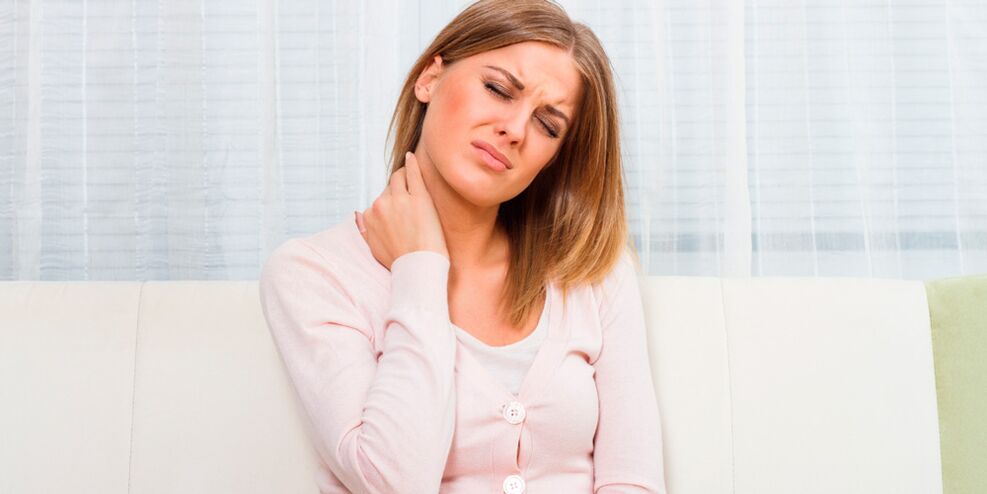
If severe pain in the neck appears suddenly and is accompanied by a temperature, then this indicates the presence of an acute inflammatory process:
- viral infection or exacerbation of a chronic inflammatory process (bronchitis, sinusitis, etc. ) - in this case, the disease is accompanied by catarrhal symptoms - cough and runny nose; what to do: if the pain is not too strong and the temperature is not high, you can wait to see a doctor; persistence of pain after recovery should be a reason to consult a doctor;
- bacterial purulent inflammatory processes - abscesses, phlegmons; what to do: consult a surgeon, because the symptoms can only be eliminated by surgery;
- autoimmune process in the joints of the cervical spine; the first symptoms appear a few days or weeks after the acute inflammatory process, there are no catarrhal symptoms; what to do: consult a doctor immediately; self-medication is contraindicated.
Severe pain in the neck, spreading to the head
Sometimes there is an acute, sudden pain in the neck in the region of the spine, radiating to the head (cervicocranialgia), associated with pinching of the spinal roots extending from the 1st and 2nd cervical vertebrae (C1 - C2) with the transmission of pain to the trigeminal nerve, whichnuclei are located in the upper parts of the spinal cord. It is the so-called radicular pain syndrome, it can be very strong and quite long-lasting. What to do: as self-help, you can take a painkiller and put an anesthetic patch on the painful area.
If the pain persists, call 911; the doctor can temporarily relieve the pain. But after you remove them, you must definitely consult a neurologist.
Aching pain in the neck and back of the head can be the result of compression of the vertebral artery. In such cases, it is often accompanied by dizziness and fainting, because the brain suffers from a lack of oxygen.
Similar pain can occur with high blood pressure (BP). The attack is accompanied by nausea and vomiting. What to do: pains in the neck and back of the head are dangerous, so if they appear, you must call an ambulance.
Neck and shoulders hurt
Aching pain in the neck may radiate to the shoulders. Typically, neck and shoulder pain is associated with muscle spasms and strains when the neurovascular bundle between the scalene muscles is compressed. Morning stiffness occurs, due to constant aching pain, the head is in a forced position: it is slightly tilted forward and towards the affected side. If the blood vessel is also compressed, dizziness, darkening of the eyes and fainting may occur. Irradiation of pain from the neck to the shoulder is also characteristic of osteochondrosis and arthrosis of the facet joints of the 5-6 vertebrae (C5-C6). When the pathological focus is localized in C5, the pain radiates along the anterior outer surface of the shoulder, so that the patient is unable to move the arm to the side.
What to do: you cannot tolerate such symptoms, you cannot cure them yourself, you should consult a neurologist.
Neck pain on the right or left side
If your neck hurts on one side:
- a very strong sudden attack- a sign of injury to the spinal roots on the right or left side; A plaster with lidocaine can help, but this is a temporary measure, it is necessary to contact a neurologist;
- sudden paroxysmal short but sharp pain in the left neck– can be a symptom of angina pectoris; if such symptoms recur, you should seek help from a therapist or cardiologist;
- aching pain on the left or right side- often develops with long-term tense position of the head due to neck muscle spasms; Use pain reliever ointments and plasters to relieve spasms; When painful muscle spasms appear, you must monitor your posture and avoid work in which your head is in a static tense position for a long time.
What to do: if you have constant or regularly recurring pain on the right or left side of the neck, it is better to start by consulting a therapist.
Severe back and neck pain
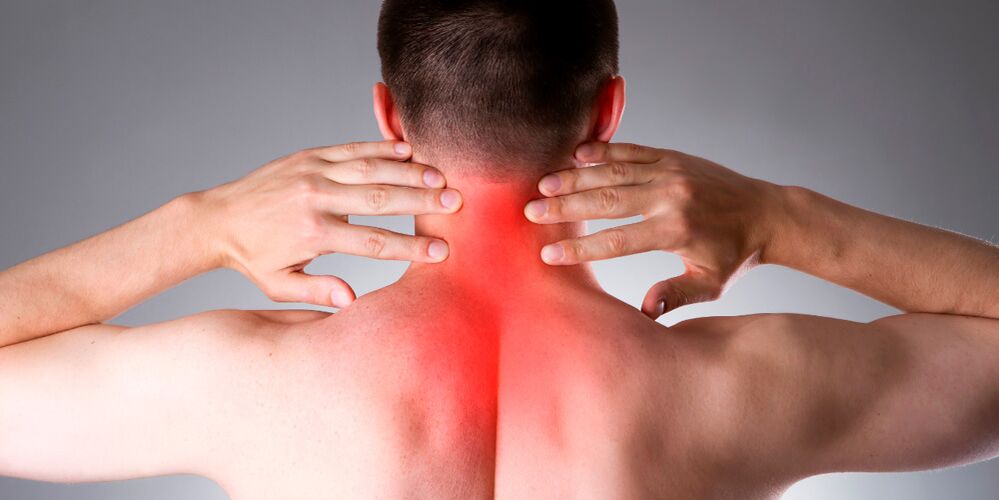
Painful sensations in the back, which are transmitted to the neck, are usually the result of osteochondrosis of the cervicothoracic spine. There is a gradual destruction of the cartilaginous intervertebral cushion that absorbs shocks - the disc. The disc becomes thinner, ruptures and can partially or completely protrude from the spinal column, compressing the nerve roots, which is accompanied by severe back pain radiating to the neck. Painful sensations are aggravated by back and neck muscle spasms.
When C6 is involved, neck pain radiates to the shoulder blade, shoulder girdle, shoulder, forearm and 1 finger. At the same time, muscle strength decreases, and hand movements require additional effort. Damage to C7 - waves of pain are transmitted to the shoulder blade, the back of the hand, the index finger and the middle finger. Symptoms of damage to C8 - possible radiation of pain along the back inner surface of the hand to the little finger.
What to do: to relieve pain, it is necessary to take an anesthetic orally and apply an anesthetic gel to the skin. After the pain subsides, consult a neurologist.
Such pain in the back of the neck can also occur with scoliosis - lateral curvature of the spine. Scoliosis can lead to squeezing and compression of the vertebrae, pinched nerves and constant aching back pain. What to do: the treatment is carried out by an orthopedic traumatologist.
Severe neck pain with radiation
Sometimes neck pain spreads to other areas. These are so-called referred pains, in which pain impulses from the main focal point spread along the nerve fibers that connect individual parts of the body and internal organs.
Pain waves can radiate from:
in the ear -painful sensations have different origins; they are most often associated with:
- with inflammatory diseases of the ENT organs - sore throat, chronic tonsillitis, laryngitis, pharyngitis; usually it is a pain in the throat and ear, accompanied by symptoms such as fever, sore throat, cough; in case of chronic inflammatory processes, the disease is not so acute, there is no temperature, the pain is moderate;
- with degenerative-dystrophic diseases of the cervical spine (osteochondrosis) and its consequences - protrusions and disc herniations; cervical pain syndrome is associated with pinching of the spinal roots by a disc protruding from the spinal column or by overgrown bone tissue of the vertebrae; Reference pain in the ear in osteochondrosis is a sign of compression of the nerve root of the 3rd cervical vertebra (C3);
- with arthritis (inflammation) or arthrosis (metabolic disorders) in the facet joints C3 - C4, connecting the cervical vertebrae;
in the teeth -painful radiation to the teeth:
- usually associated with osteochondrosis - damage to C3 – C4 vertebrae;
- have a reflective character; it is due to dental problems: deep caries and periodontitis of the teeth of the lateral part of the dentition of the upper jaw; various malocclusions; the pain can radiate from the oral cavity to the neck, there is often a feeling that the neck hurts, radiating to the teeth on the right or left side; what to do: treat or remove damaged teeth, restore bite; reflected pain syndrome can be associated with arthritis or arthrosis of the temporomandibular joint (TMJ) - it seems that your teeth hurt and the pain radiates to the neck;
in the eyes -if the upper cervical vertebrae are affected (osteochondrosis, arthritis or arthrosis of the facet joints), pain along the sensitive branches of the nerves in the neck may radiate to the eyes or tissues around the eyeball;
In the temple -often a sign of cervical osteochondrosis or TMJ arthrosis (arthritis);
in your hand -with cervical osteochondrosis or arthritis (arthrosis) of the C6-C8 joints, as well as with cervical muscle spasm;
In the spatula &ndah;C6 – C7 damage, as well as glenohumeral periarthritis;
In the collarbone -a pain syndrome can develop after an injury to the clavicle and be transmitted along the nerve fibers of the brachial plexus to the neck, as well as in arthritis or arthrosis of the shoulder joint.
When pain waves radiate to other organs and tissues, it is difficult for the patient to understand what hurts and which specialist to turn to. Therefore, it is best to start with a therapist, he will understand where to refer the patient next.
Severe pain in the neck muscles
Pain in the neck muscles is most often associated with various injuries and diseases of the spine, but it can also manifest itself as an independent disease - myofascial pain syndrome.
What to do: treatment can be started by a neurologist, but consultation with a rheumatologist may be necessary.
The back of the neck hurts a lot
Pain in the back of the head and neck is most often associated with cervical osteochondrosis and pathology of the facet joints of the cervical vertebrae. This is followed by a painful spasm of the neck muscles.
What to do: it is better to start with a consultation with a neurologist, maybe after the examination he will refer the patient to a rheumatologist.
Pain in the front of the neck in the area of the larynx
Painful sensations in the front part of the cervix, combined with difficulty swallowing, can occur with the growth of thyroid tissue (inflammatory process, goiter). At the same time, the external increase is not always noticeable, because the goitre can grow behind the sternum.
What to do: contact an endocrinologist immediately.
The larynx can hurt due to acute and chronic diseases of the ENT organs. Such diseases are accompanied by cough, sore throat, and sometimes a rise in body temperature. Laryngitis is especially dangerous, accompanied by pain, barking cough and the risk of swelling of the larynx.
What to do: consult a therapist or otorhinolaryngologist.
Neck pain when turning or bending
Myofascial pain syndrome with reflection in the area of the ear and eyeball when turning
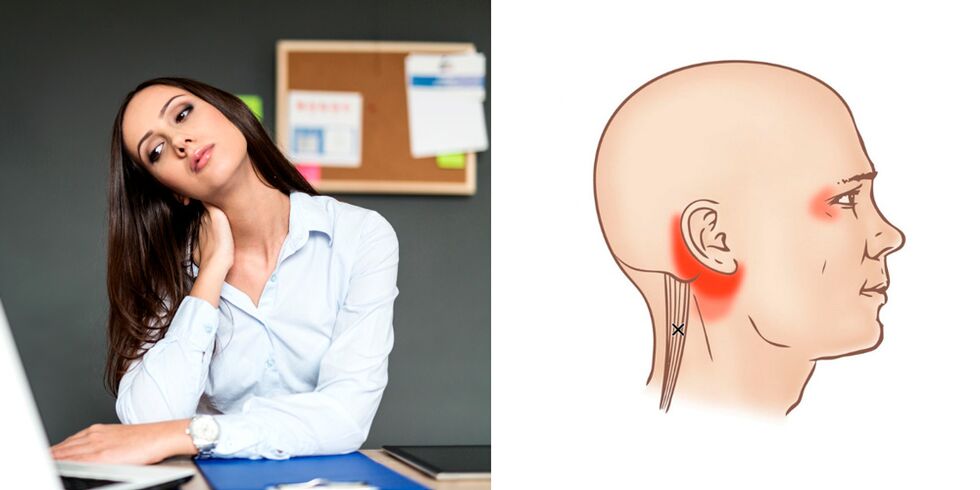
Painful turns and tilts of the head can be the result of:
- osteochondrosis and damage to spinal roots; the pain syndrome is strong and sudden, it is almost impossible to turn or tilt the head; what to do: see a neurologist urgently;
- acute neck injury or prolonged microtrauma; in the absence of bone changes (fractures, dislocations), the pain syndrome is associated with spasm and subsequent inflammation of the neck muscles; what to do: seek the help of a neurologist;
- curvature of the spine - scoliosis; the pain is painful and intensifies when bending the neck; what to do: consult an orthopedist-traumatologist.
Neck pain after sleeping
Usually, such pains rarely appear out of nowhere, they are more often associated with some hidden disease of the spine or cervical muscles. After sleeping, they appear with a long-term incorrect position of the head, which leads to compression of blood vessels and nerves. After sleeping, it manifests as aching pain, numbness and limitation of movement. After a while this goes away.
What to do: consult a neurologist and make sure that you do not have a serious pathology.
Severe pain and grinding in the neck
The causes of neck pain accompanied by crunching can be osteochondrosis, arthrosis of the facet joints or increased mobility of the neck vertebrae. In any case, it is a sign of a pathological process that can only be determined after an examination.
What to do: consult a neurologist, but you may also need the help of other specialists.
Treatment of diseases that cause neck pain
There are painkillers for temporary pain relief, but in order for the patient to be completely free from suffering, the doctor must conduct an examination and find out the cause of the pain. The patient cannot do it alone, he has to go to the clinic.
Diagnostics
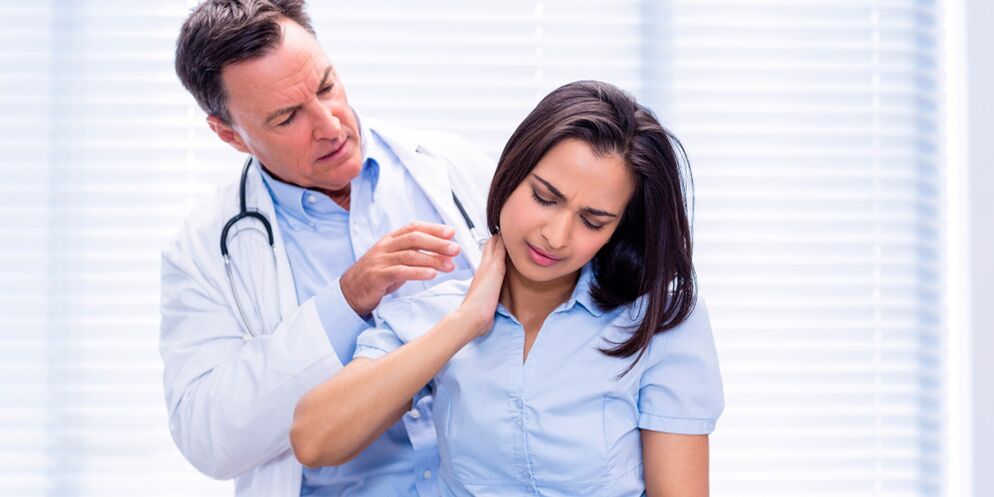
Clinical examination of the neck - the first stage of diagnosis
During the first examination, the doctor conducts a clinical examination of the patient and, based on the results, may prescribe the following additional studies:
- Laboratory tests- general clinical, biochemical and immunological blood tests. The obtained data enable the identification of inflammatory, metabolic and autoimmune processes.
- Instrumental diagnostic methods:X-ray of the affected part of the spine, if necessary– shoulder joint;Ultrasound of soft tissues;MRI or CT– a more detailed examination of the cervical region;electroneurmyography– to assess the condition of the spinal nerve root.
After the examination, the doctor can make an accurate diagnosis and prescribe treatment.
Methods for treating neck pain
Treatment of cervical pain syndrome can only be individual, as it depends on the observed disorders and the final diagnosis. Accompanying diagnoses must also be taken into account - the presence of various other diseases in the patient.
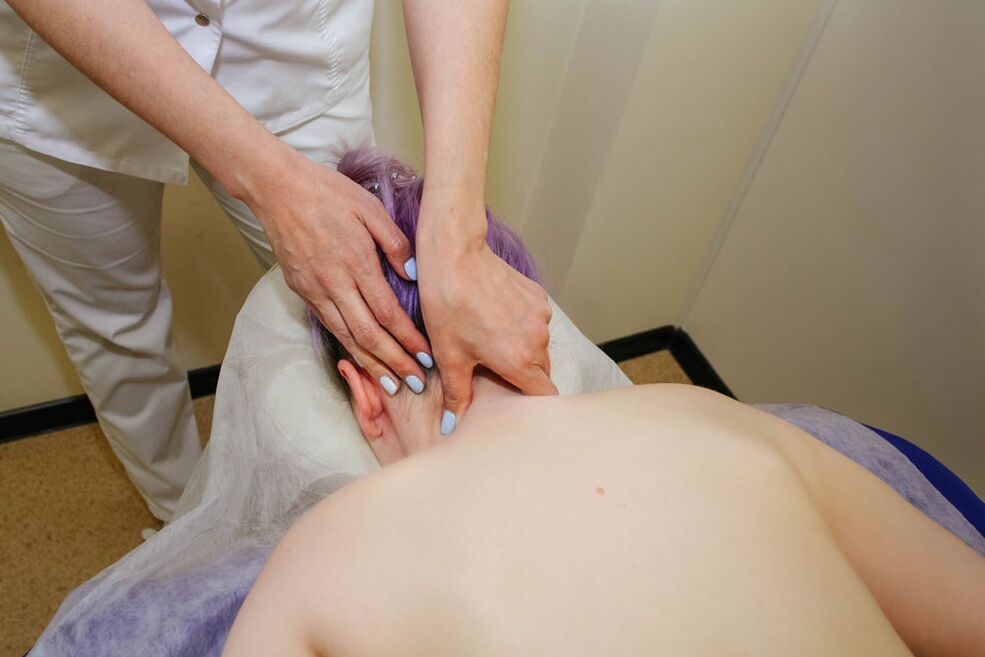
The combination of modern and traditional oriental techniques allows the patient to relieve acute pain immediately.
This restores hope for a normal life even for patients with long-term severe pain syndrome. After the course, they regularly come to the outpatient clinic for preventive treatment, which allows them to be completely free of pain and live a normal life. Contact the medical center, the doctors will surely help you!














































